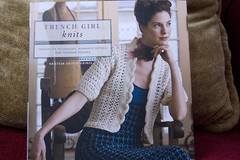First, the facts:
Title: French Girl Knits: Innovative Techniques, Romantic Details and Feminine Designs
Author: Kristeen Griffin-Grimes
Published by: Interweave Knits, 2009
Pages: 159
Type: Patterns.
Chapters:
1. La Boutique Parisienne: Romantic and Vintage Inspired
2. Enfant Sauvage: Rustic with a Gypsy Edge
3. La Creatrice: Innovative and Unconventional
4. Dans La Rue: Streetwear with Style

Pattern Size Range: Varies, but 30″ – 48″ (crossing all patterns)
The In-Depth Look:
The author opens this book by saying:
I had found a place that made sense, one that elevated the ordinary into art: the perfectly mounded, Rubenesque aubergines glistening in the sun at midday market, the precisely decorated shop windows displaying petite children’s shoes, classic shaving brushes, and frilly seed packets. I began to understand more fully what could be done with very little. The French were masters of an art that had nothing to do with money and everything to do with an appreciation of the small, lovely moments in life.” (emphasis mine)
Welcome to French Girl Knits, a book that tries to live up to that elusive ideal of French Chic.
There are 18 projects here, all for women, and all sweaters, jackets, shrugs, or vests, with the exception of one skirt. The book is split into chapters based on themes, spelled out in the chapter subtitles (“romantic and vintage inspired,” “innovative and unconventional”), and each chapter has four or five designs.
How successful are the designs? Most of them are. They are generally classic shapes, but with extra design elements, like lace gussets, or ribbing to provide shape. An unexpected cable, creative closures, or knit-in color work to accent an edge.
There’s Anjou, a lacy tie-hem tunic, which looks like it’s right out of the 1920s or 30s. Paloma, which is almost corset-inspired, but is a cap-sleeve blouse knit on fairly big needles to give it a lacy look. Then there’s Delphine, which is really corset-inspired. Nadine is a fresh, springy tunic tank with vertical lace panels to give a long, clean line. One of the quickest (looking) knits is Wrenna, a chunky cabled cardigan with cap sleeves.
The sweater that’s made each person who’s flipped through my copy stop and say, “ooh?” That would be Simone, a flared-sleeve, wide-necked cowl sweater with lace insets at the side seams. This design is sharp and stylish. I love the Viola cardigan, too. In fact, it’s the one that’s calling me to my knitting needles. A sweet, short-sleeved cardigan with knitted-in ruffles at the sleeves and neckline. It’s fresh and oh-so-pretty. I like the Martine hoodie, too, which looks eminently wearable, as does the Chanel-inspired cropped Bijou.
Cybelle is one of the few missteps, I think–a horizontal, cabled vest held together by lacing in the front and buttons in the back, and looking like something out of Clan of the Cave Bear (if they had had knitting). This design is trying so hard to be edgy and unique, it feels completely out of place in this book, surrounded by designs inspired by Chanel and that French chic. (Not that the French are never edgy and hip, but, you know what I mean.)
The lone skirt is unique, too–a wrap-around that doesn’t completely, um, wrap around. It clasps at the waist but leaves a slit that would be quite daring to wear without something underneath. (It’s modelled over a white chemise, which makes it look lovely rather than risque.)
Inside each chapter is an overview of a construction technique–Side-to side seamless, Top-down seamless raglan, Bottom-up seamless raglan, and Top-down seamless set-in sleeve, and Bottom-up seamless set-in sleeve. These overviews are excellent. Short and sweet, but explaining the IDEA of the technique, with schematics to illustrate the various steps. The only real problem is that they kind of get in the way of the patterns. I would have much preferred to see them gathered together into a chapter of their own at the back (or front) of the book. As it stands, they act more like speed bumps. You page through the patterns, feeling inspired, and then, bump! a multi-page treatise on how to shape a raglan sleeve.
The occasional sidebars scattered through the book don’t have this problem, since they’re “smaller.” Tips on yarn substitution, or grafting mohair yarn–those sidebars don’t act as interruptions so much as illustration.
The illustrations–always vital in a knitting book–are good. Nice pictures that show the actual shape and detail of the sweaters, without odd posing or a worrisome multiplicity of props that could be hiding problems. The instructions seem clear, and the more complicated patterns come with “notes” to help you along.
This book is available at Amazon.com.
Want to see bigger pictures? Click here.

This review copy was kindly donated by Interweave Press. Thank you!


Comments on this entry are closed.
Thanks for the review.
My copy came yesterday and I love the book. Your review is really right about the layout. I would love all the special info together but want to start several of the sweaters immediately.
I’m contacting the company, Interweave, for a comment. The picture of Veronique shows a seam in the sleeve but the directions say they are knit in the round. Thought I’d let you know.
I saw the cover sweater, Sophia, in real life at TNNA a week ago. The front is beautiful, but the *back* of the sweater is incredible. The waist-shaping decreases are worked to make an attractive inverted “V” shape. Elegant.